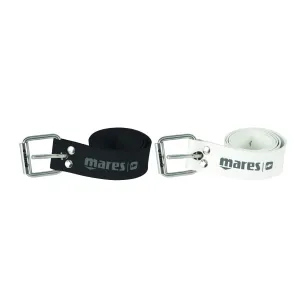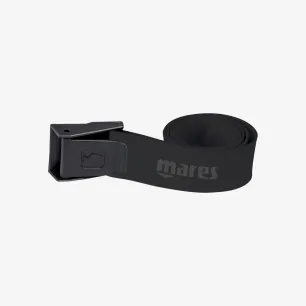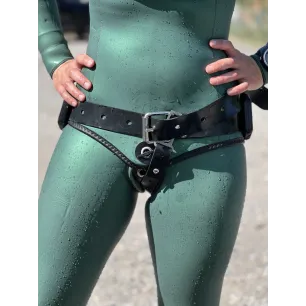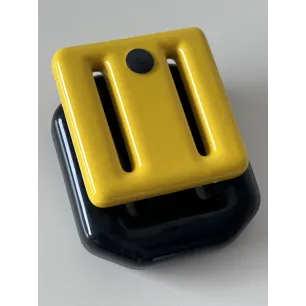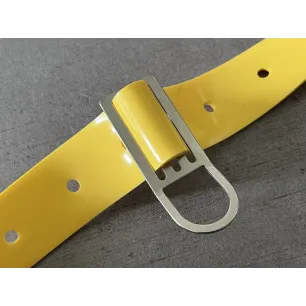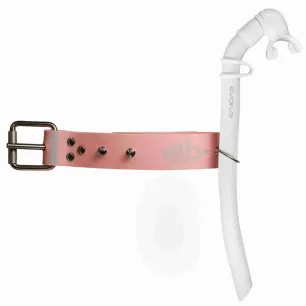
Archimedes' Principle
You might remember from school lessons the Archimedean Principle or the Law of Archimedes? It says that a body immersed in water receives a buoyancy equal to the weight of the displaced water. You can read this in detail here: Archimedes Principle on Wikipedia.


An Example of the Archimedean Principle
A freediver weighs 80kg, so if it is completely immersed in water, a force corresponding to the weight of 80kg pulls down (actually, it is 784 Newtons, because forces are measured in "Newtons"). His body displaces 85 litres of water and thus acts on him an upward force equivalent to 85kg (833 Newton). Thus, the diver must add at least 5kg of lead in order to be able to dive underwater without exertion.
The same diver from the previous example wants to be neutral (or slightly negative) at the bottom of the pool in the pool. He still weighs 80kg, but since his rib cage has already lost its circumference at 1.5 bar ambient pressure, he displaces only 83 litres of water. Its buoyancy corresponds to 83Kg and thus 3Kg of lead is enough to be able to lie comfortably at the bottom of the basin.
The diver freezes and puts on his 5mm suit. The diver now weighs 81 kilograms with his suit. Just below the surface, thanks to the 5mm layer of neoprene on his body, he is now displacing 88 liters of water. So to be neutral on the surface, he has to put on 7kg of lead. At the bottom of the pelvis, on the other hand, not only is its rib cage compromised, but also the air bubbles in the neoprene have lost 25% of their volume. So it now displaces 86 litres of water and is markedly negative with its 7kg of lead.
What does the Archimedean Principle mean for freedivers in the pool
If you wear a wetsuit in the pool, you have to balance the buoyancy with a lot of lead if you want to dive dynamically at a depth of about 1m. With thick suits (5mm jacket and trousers) the amount of lead required is so large that it is hardly possible to be stable at a depth of 1m. Even the smallest differences in depth have a strong effect on the compression of the suit and the diver drifts to the surface or sinks to the bottom.
Conclusion: Dynamic in the pool best only in swimwear. If it is too cold for you, wear a thin (1mm or 1.5mm) suit or a maximum 3mm thick suit jacket without trousers.
What does the Archimedean Principle mean for freedivers in open water?
In the open water, most freedivers aim for a Neutral Lift at depth of 8-12m. This is achieved in a 5mm suit with about 3-4kg of lead. If you have a 1/2kg piece of lead in the buoy, you can adjust your weight in 500g increments, which is usually enough. Do a surface buoyancy test in the open water first: If you breathe in and out normally while standing in the water column, the water line should be about the level of your eyes. If you breathe out completely, you may sink down to about your forehead but never start to sink further! If you don't have enough lead, your duck dive needs to be very efficient and the descent is long and exhausting. If you're overweight, you won't be able to relax on the surface and run the risk of not drifting on the surface in the event of a blackout!
How many lead weights do you need in the pool?
In order to be neutral in the pool at a depth of about 1m or in the open water at about 10m, a diver needs weight in the form of lead pieces, which are carried on a harness on the lower abdomen or in the form of neck lead. Only with the right amount of lead, one can dive comfortably in the pool and use all the power of the fins for propulsion. I, 173cm tall and 80kg, need 2kg of lead in the pool in swimming trunks, with 3mm suit jacket 4kg. With 3mm suit jacket and trousers approx. 6kg
How much lead in open water?
In open water, the right amount of lead is not only important to be able to submerge and submerge with as little energy as possible (and thus oxygen consumption), but it is also decisive for safety: only so much lead on the body that even in the exhaled state one does not begin to sink at the surface! In fresh water I use 4Kg with 5mm suit and in salt water 5Kg lead.
Lead in the sea?
As a rule of thumb, 1 kg of lead per mm of neoprene thickness, which one carries. Also here always do a buoyancy test first, because salt water has a different density depending on the area.
How do you wear a lead belt?
Most freedivers, and especially female freedivers, wear the lead belt too high at the waist. The result, especially when you dive upside down, is that the lead belt slides up towards your chest. A freediving lead belt made of rubber or silicone is worn at the level of your bladder, which is very low. Women with a slender waist can use a crotch strap to prevent the lead strap from slipping upwards.
10 products




